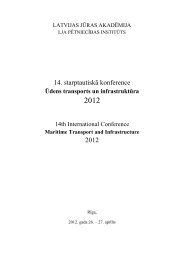You also want an ePaper? Increase the reach of your titles
YUMPU automatically turns print PDFs into web optimized ePapers that Google loves.
For three years the Riga port handling ranged from 308.5 thousand tons to 398.91 thousand tons peryear. The first eighteen months of the period did not exceed 378.64 thousand tons (Decile2=378,64),therefore, it can be said that the Riga port handling a longer period of time, was less than the averageannual grain handling, so in future periods is most likely that the Riga port will handle less than 444thousand tons of grain.Klaipeda seaport loading rates fluctuated (Vσ =21%) in 2011 reduction reached 25% compared to2010, but in 2012, the load factor increased by 54%, which means that the annual growth rate was 154%.During whole period the absolute annual average increases to 14.2 thousand tons. Riga port during theanalysis period, steadily loaded almost every year, more and more, an average of 68.71 thousand tonsannually from 2009, when it was recorded in a reduction in grain handling. It must be emphasized thatalthough the Riga port grain handling descriptive statistics indicators are significantly lower than theKlaipeda seaport, however, the grain growth rate is faster than the Klaipeda seaport and grain handlinggrowth rate of more than 4 times who has a big effect on grain yield transit from Kazakhstan.Figure 3. Grain handling trends at Klaipeda and Riga seaportsAccording to the linear trend method of grain handling trends in both ports and holding thecorresponding periods of the next economic development patterns in respect of the investigation period itcan be said that after 10 years of Klaipeda and Riga seaport grain handling will be the same – 1337.33thousand tons.However, a grain handling development trends of Sea port of Klaipeda depend varied extensivelyand prediction error can be greater than the allowed 10 percent, and such fluctuations can be explained bychanges in grain import and export performance dynamics and changes to infrastructure and investmentin bulk cargo terminals. The causation analysis allowed establishing the fact that the Klaipeda seaporthandling is not linear over the import, than the export macroeconomic indicators, while Riga sea portindicators directly depend on the export and import values.Figure 4. Riga port grain handling linear dependence on the country import and export rateAccording to Figure 4 Regression models suggest that the relationship between macro-economicindicators are very strong, but significant changes in the handling of grain does not predict: exportsincreased a thousand LVL, grain handling changes are not significant, increase in turnover in just 800kilograms, and the increase in imports of one thousand tons. Forecasting the growth of imports by 1percent can be predicted that the grain handling at the port of Riga increased only 0.5 percent Suchdependence indicates that the Riga seaport intensively served by transit cargoes of grain from Eastern86
















